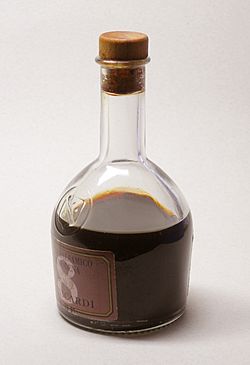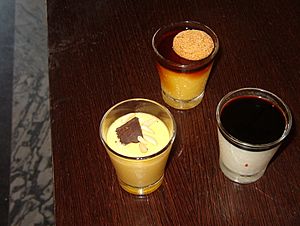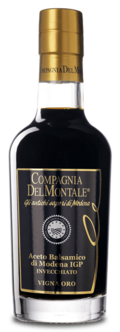Balsamic vinegar facts for kids

A bottle of Aceto Balsamico di Modena, aged for eight years
|
|
| Type | Condiment and salad dressing |
|---|---|
| Place of origin | Italy |
| Region or state | Modena and Reggio Emilia |
| Main ingredients | White Trebbiano grape juice |
Balsamic vinegar (Italian: aceto balsamico) is a special kind of vinegar from Modena, Italy. It is very dark, thick, and has a strong, rich flavor. It's made from "grape must," which is freshly crushed grape juice with all the skins, seeds, and stems.
The name aceto balsamico can be used for many products. However, there are three types of balsamic vinegar that are officially protected. These are Aceto Balsamico Tradizionale di Modena DOP, Aceto Balsamico Tradizionale di Reggio Emilia DOP, and Aceto Balsamico di Modena IGP. The two "Traditional" types are made in a very specific way. They use grape must that is cooked down and then aged for many years in wooden barrels. These are only made in the Modena or Reggio Emilia regions of Italy. Their names are protected by the European Union. The "Balsamic Vinegar of Modena" (Aceto Balsamico di Modena) is usually less expensive. It's made from grape must mixed with wine vinegar. It also comes from Modena or Reggio Emilia and has a special protected status.
Balsamic vinegar does not contain any "balsam" or "balsa" wood.
Contents
What Does "Balsamic" Mean?
The Italian word balsamico comes from an old Latin word. It means "balsam-like," which suggests something "restorative" or "curative." Think of it like a "balm" that helps you feel better. The word originally meant "perfume" or "spice."
Types of Balsamic Vinegar
There are three main types of balsamic vinegar that have special protection:
- Aceto Balsamico Tradizionale di Modena DOP (Traditional Balsamic Vinegar of Modena)
- Aceto Balsamico Tradizionale di Reggio Emilia DOP (Traditional Balsamic Vinegar of Reggio Emilia)
- Aceto Balsamico di Modena IGP (Balsamic Vinegar of Modena)
You might also find many products that use "Aceto Balsamico di Modena IGP" as an ingredient. These include glazes and other sauces.
Traditional Balsamic Vinegar (DOP)
Only two groups of producers make true traditional balsamic vinegar. They are located in Modena and nearby Reggio Emilia. This special vinegar is made from cooked-down juice of Trebbiano and Lambrusco grapes. This thick syrup is called mosto cotto in Italian.
After cooking, the syrup is aged for at least 12 years. It sits in many wooden barrels, each one smaller than the last. These barrels are made from different woods like chestnut, cherry, oak, mulberry, ash, and juniper. True balsamic vinegar is rich, shiny, and deep brown. It has a complex flavor that is both sweet and sour, with hints of wood from the barrels.
Reggio Emilia uses different label colors to show how old their traditional balsamic vinegar is:
- A red label means it's aged for at least 12 years.
- A silver label means it's aged for at least 18 years.
- A gold label means it's aged for 25 years or more.
Modena uses a different way to show the age of its traditional balsamic vinegars:
- A white cap means it's aged for at least 12 years.
- A gold cap with "extravecchio" (extra-old) means it's aged for 25 years or more.
Balsamic Vinegar of Modena (IGP)
These are the balsamic vinegars you usually see in stores. They are made to be similar to the traditional product. They can have as little as 20% grape must. This grape must doesn't even have to come from Modena or Reggio Emilia. Wine vinegar, coloring, caramel, and sometimes thickeners are added. These additions help make it look and taste like the aged traditional vinegar.
For this type of balsamic vinegar to have "IGP" status, it must be aged for at least two months. If it's labeled "invecchiato" (aged), it must be aged for three years. This aging doesn't always happen in wooden barrels. Because it's made in large factories, a medium-sized producer can make hundreds of liters every day.
In 2009, the European Commission officially recognized "Balsamic Vinegar of Modena" (Aceto Balsamico di Modena) with its special "IGP" status.
Other "Balsamic" Dressings
You might see products called condimento balsamico, salsa balsamica, or salsa di mosto cotto. These are balsamic "dressings." Sometimes, these names can be confusing for people looking for the original protected balsamic vinegars.
These "condimento" balsamic vinegars can be made in a few ways:
- They might be made by the same companies that produce the protected balsamic vinegars. If they use the protected vinegar as an ingredient, they must clearly say so on the label, like "Glaze with Aceto Balsamico di Modena IGP." The official groups must approve these labels.
- They might be made using similar methods but by producers outside of Modena and Reggio Emilia. These products cannot use the names Modena or Reggio Emilia, and they are not supervised by the official groups.
Since there are no official rules for labeling "condimento" balsamic vinegar, it can be hard to know their quality just by looking at the package.
How Traditional Balsamic Vinegar is Made
Traditional balsamic vinegar starts with the juice of freshly picked white grapes, usually Trebbiano grapes. This juice is boiled down until it becomes a thick "must" with at least 30% sugar. Then, it slowly ferments and ages, which makes the flavors stronger.
Over many years, the vinegar is stored in wooden casks. It becomes sweet, thick, and very concentrated. During this time, some of the vinegar evaporates. This evaporated part is sometimes called the "angels' share." This term is also used for other aged drinks like bourbon whiskey or wine.
None of the vinegar can be taken out until it has aged for at least 12 years. After this minimum aging time (which can be 12, 18, or 25 years), a small amount is taken from the smallest barrel. Then, each barrel is refilled with vinegar from the next larger barrel. Freshly cooked grape must is added to the largest barrel. This process, where older vinegar is replaced by slightly younger vinegar, is called the solera system. It helps keep the quality consistent.
How Balsamic Vinegar is Used

In the Emilia-Romagna region of Italy, traditional balsamic vinegar is often served in small drops. It's put on chunks of Parmigiano Reggiano or mortadella as a starter. It's also used in small amounts to make steaks, eggs, or grilled fish taste better. You can even find it on fresh fruit like strawberries and pears, or on plain gelato (Italian ice cream). Some people even sip traditional vinegar from a tiny glass at the end of a meal.
Today, chefs use both Traditional Balsamic Vinegar (DOP) and Balsamic Vinegar of Modena (IGP) in simple dishes. They use it to make the complex flavors of the vinegar stand out. For example, it can be used to improve dishes like scallops or shrimp, or on simple pastas and risottos.
Images for kids
See also
 In Spanish: Aceto balsámico para niños
In Spanish: Aceto balsámico para niños








